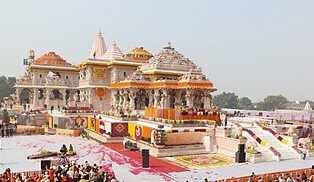Some interesting facts about the Ram Temple: The Ram Temple in Ayodhya is a symbol of architecture, devotion, and history. Built on the birthplace of Lord Ram, this magnificent temple is now an important spiritual and cultural icon. Every element of the temple, from its exquisite Nagara style architecture to its iconic idols made of rare Shaligram stone, symbolizes India’s rich history. It is a famous and captivating building that incorporates unique elements, including soil from sacred sites, a time capsule, and a unique rock from Ashoka Vatika in Sri Lanka.
We have compiled some interesting facts about the Ram Temple here.
Who designed the temple?
The Ram Temple was designed in 1988 by the Ahmedabad-based Sompura family, who, over 15 generations, have built over 100 temples worldwide, including the famous Somnath Temple. However, in 2020, some changes were made to the design in accordance with the concepts of Shilpa Shastra and Vastu Shastra.
Temple Area
The temple is three stories tall and spreads over 2.67 acres. It has five pavilions, 46 entrances, and 390 carved pillars. The temple is 161 feet high, 380 feet long, and 250 feet wide. A miniature statue of Lord Rama is installed in the sanctum sanctorum, and the Shri Ram Darbar will be established on the first floor.
Architectural Style
The Ram Temple is built in the Nagara style and is constructed from pink sandstone brought from Mirzapur and Bansi-Paharpur in Rajasthan. A central spire surrounded by small turrets (mukh mandapas) is the hallmark of this architectural style.
Idol in the Sanctum Sanctorum
Created from Shaligram stone found in the Gandaki River in Nepal, a 51-inch black idol of Lord Rama as a 5-year-old child is installed in the main sanctum sanctorum. The idol took 7-8 months to carve.
Entry for Devotees
To enter the temple, visitors must climb 32 steps, which are 16.11 feet above the ground. There are also elevators and ramps to ensure access for the elderly and disabled.
Holy Soil and Holy Water
The temple’s foundation contains precious soil from 2,587 locations, including Jhansi, Haldighati, and the Golden Temple. The inauguration ceremony included water from 155 sacred rivers and soil from 2,000 pilgrimage sites. A time capsule buried 2,000 feet beneath the temple contains information about the history of Ayodhya and the birthplace of Lord Rama.
Representation of the Solar System
The temple features a garden with plants representing the 27 nakshatras (astrological constellations). Furthermore, the temple is designed to last for over 2,500 years and is also earthquake-resistant.
A Special Gift from Sri Lanka
The temple has received a stone gift from the ancient Ashoka Vatika in Sri Lanka, where Ravana held Sita captive. By avoiding the use of iron, the building will last for more than a millennium.
Modern Facilities in the Complex
The Ram Temple complex includes the following modern facilities:
- Emergency medical services
- Banks and ATMs
- Solar panels and power backup
- Ramps and elevators for senior citizens
- Pilgrim Facilitation Centre for visitor management
- Public facilities such as toilets, bathrooms, and washrooms.
Instagram page: authentic_aipan

